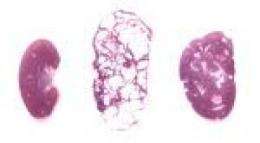Research points to potential treatment for kidney disease

Research performed at UC Santa Barbara points to the drug rapamycin as a potential treatment for kidney disease. The study builds on past research and shows that studies performed on mice are more likely to translate to humans than previously thought. The results are published in the current online issue of the Journal of the American Society of Nephrology.
Over 600,000 people in the U.S., and 12 million worldwide, are affected by the inherited kidney disease known as ADPKD, short for autosomal-dominant polycystic kidney disease. In the U.S., the number of individuals affected by ADPKD is greater than the number affected by cystic fibrosis, muscular dystrophy, hemophilia, Down's syndrome, and sickle cell anemia combined. The disease is characterized by the proliferation of cysts that eventually debilitate the kidney, causing kidney failure in half of all patients by the time they reach age 50.
Currently, no treatment exists to prevent or slow cyst formation, and most ADPKD patients require kidney transplants or lifelong dialysis for survival, explained Thomas Weimbs, director of the laboratory where the discovery was made. Weimbs is an associate professor in the Department of Molecular, Cellular and Developmental Biology and the Neuroscience Research Institute at UCSB.
The drug rapamycin, also called sirolimus, is currently used as an immunosuppressant, to help prevent rejection of a new, transplanted kidney.
"While we had previously shown that rapamycin is highly effective in mouse models of polycystic kidney disease, the problem had been that these mice had different genes affected than human patients," said Weimbs. "Therefore, the question always remained whether rapamycin would be effective in patients, too. Our new study now is the first to show that rapamycin is also highly effective in a new mouse model in which the same gene is affected as in most human patients."
Currently, there are several clinical trials ongoing internationally to test the safety and efficacy of rapamycin and related drugs in polycystic kidney disease, explained Jonathan Shillingford, UCSB project scientist in the Department of Molecular, Cellular and Developmental Biology, and first author on the paper. First results from these studies are expected to appear this year. The scientists hope that these drugs will prove to be beneficial. "But it will be critical to balance any benefits against the expected side effects to judge whether these drugs should be recommended for the treatment of polycystic kidney disease," he said.
The Weimbs lab has studied rapamycin in mice for several years. "To our surprise, treatment of our polycystic kidney mice with rapamycin resulted not only in a halt of further cyst growth but also appeared to partially reverse the already existing kidney deterioration," said Weimbs. "We had seen this previously in a different mouse model but were very positively surprised that this effect can be replicated in our new model."












